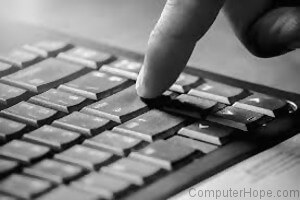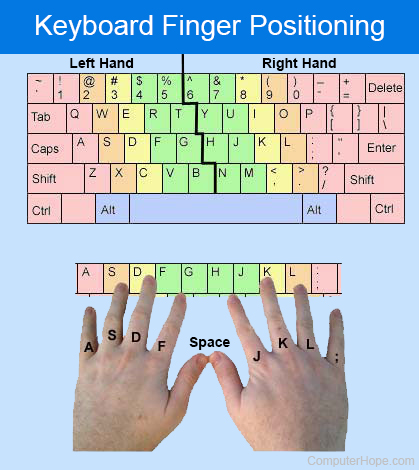How to use a computer keyboard
How to use a computer keyboard
Updated: 12/30/2019 by Computer Hope

A computer keyboard is an input device used with all types of computers. Newer devices like a smartphone and tablet even still use an on-screen keyboard.
This page is designed to help new computer users become more familiar
and efficient with their keyboard. For new users, we suggest reading
through all of the below sections and doing all of the practices.
- Connecting the keyboard.
- Familiarizing yourself with the keyboard.
- Overview of each section of the keyboard.
- Start typing and how to position hands.
- Correcting errors.
- Deleting text one letter and one word at a time.
- Using the arrow keys to move around.
- Uppercase, lowercase, and all caps.
- Getting to the beginning and end of a line.
- Highlighting text using the keyboard.
- Copy and paste text using the keyboard.
- Using the 10-key.
- Keyboard shortcuts.
- Additional practice sentences.
Connecting the keyboard
Before you can use the keyboard, it must be connected
properly to the computer. If you have a new computer and need help
connecting the keyboard, or the keyboard is not working, see our steps
on connecting and installing a keyboard.
Familiarizing yourself with the keyboard
Below is an overview of a desktop computer keyboard. This
picture shows the major sections of the keyboard. Each section is
explained in detail below.

Overview of each section of the keyboard
Alphanumeric keyboard
The alphanumeric keyboard is the primary portion of the keyboard that contains letters, numbers, punctuation, and some of the symbol keys. Today, most users use a QWERTY
style keyboards, as shown in the below illustration. You can tell if
you are using a QWERTY keyboard by looking at the first six letters to
see if they spell "QWERTY."

See the link below for a full listing of each key and symbol and their functions.
Function keys
The function keys
or F1 through F12 or F19 keys are used in programs as shortcut keys to
performed frequently performed tasks. For example, the F1 key is the key
to open the online help for most programs.
On some keyboards, the function keys may be used to activate additional functions on a computer. Used in combination with the Fn key,
the function keys can activate other functions, like changing screen
brightness, accessing media controls, or turning off the computer.

Control and toggle keys
The control keys or toggle keys give the user additional control over text manipulation and cursor placement. They may also be used as shortcut keys in many programs. See our control keys definition for additional information and examples.
Keypad
Although not available on all computer keyboards,
especially laptops; the keypad gives the user quick access to numbers
and math functions such as plus, divide, times, and subtract. See the keypad definition for further information, pictures, and related links.
Wrist pad
In our example picture, the Saitek keyboard has a wrist
pad intended to help support the user's wrists. Although many keyboards
do not include a wrist pad, hundreds of different options can be
purchased at a computer store or online.
Warning
Experts debate the need for wrist pads and many ergonomic experts argue a wrist pad may be more stressful and may help cause carpal tunnel.

Arrow keys
The arrow keys are four directional keys that allow you to move the cursor or change a highlighted selection. See our arrow keys page for further information.
Special keys or media keys on a multimedia keyboard
Multimedia keyboards have additional buttons not found on a traditional keyboard. See our special keys page for further information.
Start typing and how to position hands
Before typing, place your hands in the proper position, with your fingers on the home row keys.
When you are typing, glance at your fingers to make sure that each
finger is pressing the correct key. Below is a picture to help
illustrate where each finger should be positioned as well as the home
row keys. Your left-hand fingers should be positioned over A, S, D, and F
keys and your right hand should be positioned over the J, K, L, and ;
keys. Also, each color helps illustrate what fingers are responsible for
what key.

If you have never learned how to type properly and use the hunt-and-peck
method of typing, we strongly encourage you to practice throughout this
page using the proper technique. Not only does this improve your typing
efficiency it also reduces the strain you may encounter while typing
from having to look down at the keyboard.
Once your hands are in the proper position practice typing the below sentence that has every letter in the alphabet.
Practice typing every letter
Correcting errors
It is inevitable as you type that you are going to make errors the backspace key and delete key
can help you correct these errors. Using the backspace key erases one
character to the left of the cursor and delete erases one character to
the right of the cursor.
Note
Apple computer keyboards have two delete keys. The big delete key on
the keyboard acts the same as a backspace key, and the other delete key
acts as a delete key.
Use the below practice are to practice correcting errors.
Correcting errors
Using the arrow keys to move around
One of the best methods to improve your efficiency on the keyboard is to avoid using the mouse
whenever possible. Having to move your hand away from the keyboard to
the mouse and then back to the keyboard wastes a lot of time. One method
of avoiding the mouse is to use the arrow keys to move the cursor
instead of using the mouse to move the cursor.
In the practice area below, use the arrow keys to move
the cursor, move it around within a line of text, make corrections to
errors, and add new text.
Practice using the arrow keys
Tip
Press the "Tab" key on the keyboard to place the text cursor jump in
the text field below. Pressing "Tab" on a web page moves the cursor or
selection to the next available interactive element, such as a button,
text field, or hyperlink.
Deleting text one letter and one word at a time
It may also be necessary to delete more than one letter
or even a word at a time. Use the below practice to delete all of the
text from a line.
Practice deleting one letter and one word at a time
Uppercase, lowercase, and all caps

Unless your Caps Lock key is turned on, your computer types everything in lowercase. To make the first letter of a sentence or word uppercase, hold down the Shift key on the keyboard and press the letter you want to capitalize.
If you want all of the words capitalized press the Caps Lock key,
which should turn on an LED indicator indicating it is enabled. Once
enabled, everything remains capitalized unless you hold down the Shift
key or press the Caps Lock key again.
Use the below practice to type text in uppercase and lowercase.
Practice using the arrow keys
Getting to the beginning and end of a line
The Home key and End key
can also be used to get to the beginning of the line. Use the below
practice to get to the beginning and end of the line of text.
Practice going to the beginning and end of a line using the keyboard
Highlighting text using the keyboard
It is also possible to highlight text using the keyboard with the Shift key. Follow the below practice to highlight text in the below sentence.
Practice highlighting text using the keyboard
Tip
When text is highlighted, you can press the delete key to delete all highlighted text or start typing to replace highlighted text.
Copy and paste text using the keyboard
Copying and pasting text is something every computer user is going to do more than once. Knowing how to copy and paste text using the keyboard can save you a lot of time when using the computer.
Practice copying and pasting text using the keyboard
Tip
You can also cut the text instead of copying the text if you want to move the text from one box to the other box. To cut text, you use the Ctrl+X or Cmd+X keyboard shortcut.
Further steps and information on copying and pasting text using the keyboard, mouse, or touch screen on any device is also on the link below.
Using the 10-key

If your keyboard has a numeric keypad, it can save you a lot of time when you're typing numbers in a calculator or spreadsheet.
Before using the 10-key make sure your right hand is properly positioned on the keypad. The home row
for the numeric keypad is 4, 5, 6, and Enter. Your index finger on your
right hand should be on the number 4. Your middle finger should be on
5, you ring finger on 6, and your pinky should rest on the Enter key.
Tip
There is usually a small bump on the five key to help position your right hand without looking.
After your hand is in the position, you can use the below practice to practice using the keypad.
Keyboard 10-key practice
Note
If your keyboard has a Num Lock key, the Number lock must be turned on for the numbers to work on the keypad.
Tip
Another good way to practice using the 10-key is to open the
calculator on your computer and enter numbers using the calculator.
Pressing the Enter key on the 10-key with your pinky after entering a
math formula gives you the total.
Keyboard shortcuts
One of the best methods of becoming more efficient with your computer is to learn and memorize as many keyboard shortcuts
as possible. As mentioned above, your typing becomes much faster if you
don't have to move your hand to the mouse. So, keyboard shortcuts help
increase the speed at which you can use your computer.
Computer Hope has hundreds of keyboard shortcuts for
popular programs and operating systems. Below are a few links to our
keyboard shortcuts to help get you started.
Additional practice sentences
Practice makes perfect, and the only way to increase your
speed and become better at typing is to practice. Below are some more
sentences to practice that also relate to the everything you learned on
this page. Not only is doing the below practices going to help you learn
to type, but it also helps reinforce everything you learned on this
page and teach you a little more.
How to use a computer keyboard
![How to use a computer keyboard]() Reviewed by Cadotz media
on
January 26, 2020
Rating:
Reviewed by Cadotz media
on
January 26, 2020
Rating:

















Post a Comment